

Vol. 38 (Nº 58) Year 2017. Page 20
Rafael Mattos DEUS 1; Júlia Panzarin SAVIETTO 2; Rosane Aparecida Gomes BATTISTELLE 3; Aldo Roberto OMETTO 4
Received: 02/08/2017 • Approved: 01/09/2017
ABSTRACT: This paper analyzes the current state of research on circular economies, using bibliometric tools. This theme is still emerging, as published articles in the Web of Science were encountered since only 2006, although the number of articles per year has grown. There is a broad field of research on circular economy that identifies its potential impacts in the present and the future to create a favorable environment and basis for accelerating an economic transition toward sustainability. |
RESUMO: Este artigo analisa o estado-da-arte do tema economia circular por meio de ferramentas bibliométricas. Este tema ainda é emergente, já que os artigos publicados na base Web of Science foram encontrados a partir de 2006, entretanto o número de artigos por ano tem crescido. Existe um amplo campo de pesquisa sobre a economia circular com potenciais impactos para o presente e o futuro, criando, assim, um ambiente favorável que acelere uma transição econômica rumo à sustentabilidade. |
In the period from 1910 to 2005, the human population grew four times and the economy seventeen times, although human appropriation of net primary production, measured in carbon units, has only doubled, signifying a breakthrough in efficiency. Even so, human net primary production remains high, from 6.9 Gt to 14.8 Gt of carbon per year, reaching 25% of the net primary production potential of potential vegetation (Krausmann et al., 2013). In addition, there has been an exponential increase in waste generation during the same period as well as significant economic growth without correspoding environmental awareness of the population. These factors, in addition to inefficient public management and increasing fossil fuel consumption, put into question the current economic model (Deus et al., 2017a; Hoornweg et al., 2013).
In this context, human actions are drivers of environmental and climate change (Georgescu et al., 2014). Resulting wastes from the consumption of products, whether organic or inorganic, can potentially contribute toward greenhouse gas emissions, depending on their final treatment or disposal, thereby contributing toward global warming (Deus et al., 2015, 2017b; Gentil et al., 2009).
However, there is some contradiction in the literature as to whether waste contributes to global warming (Vergara and Tchobanoglous, 2012). Today’s society and its actors have begun to seek the efficient use of fuels and natural resources in order to reduce greenhouse gas emissions and adverse environmental impacts. Different methods, tools, and techniques, such as life cycle assessment, assess the inputs and outputs of product systems and their potential environmental impact (ISO, 2006) and illustrate the greater environmental awareness of different industries (Hou et al., 2015; Souza and Barbastefano, 2011).
Furthermore, the current economic model of extracting, transforming, and discarding depends on the low cost of and easy access to raw materials and energy. However, with recent pressures on natural resources, the circular economic model represents a new way of rethinking and reformulating the use of materials and energy (Ellen MacArthur Foundation, 2015; Geng et al., 2013).
In this model, material flows are like biological cycles. After materials are disposed of following one process, they are made available for a new cycle. Thus, materials are designed to have a cyclical metabolism. In this sense, an information network of uses and reuses binds the different actors of a circular economy in order to add greater value to products and services (Braungart et al., 2007).
In this way, the goal of this study was to analyze the current state of research on the circular economy using bibliometric tools that considered the main authors, institutions, countries, and keywords of related academic studies.
Sustainability remains a hotly debated issue for both post-industrialized and industrialized nations, many of which are still in the early stages of sustainable development.
Until the 1960s, most industries had little regard for environmental issues. Following a paradigm outbreak in the 1970s, greater focus was placed on controlling pollution through end-of-pipe treatment. During this decade, major world meetings were held on the issue of pollution, and the Environmental Protection Agency of the United States was created (Hoffman, 1999; Velloso, 2008). Meanwhile, Brazil created the Special Secretariat of the Environment (Secretaria Especial do Meio Ambiente - SEMA) with the objective of promoting the appropriate use of natural resources for environmental conservation (Brasil, 1973).
Throughout the 1980s, production models transitioned toward those that would prevent pollution and minimize waste. In the 1990s, this approach incorporated product management and life cycle analysis, enabling a further reduction in pollution and decision making based on the contribution toward contamination of different raw materials and products (Hoffman, 1999).
In the 90s, along with the development of new methodologies, the industrial ecology movement began along with industrial symbiosis, which engages traditionally separated industries in a collective approach in order to create competitive advantages through the exchange of materials, energy, water, and by-products (Chertow, 2000). Figure 1 shows that, at first (1997–2005), industrial symbiosis had a low representation in the scientific literature. Over time (2006–2012), the number of publications increased, including diverse research approaches and theories, which has led to the enrichment and maturation of this field of study (Yu et al., 2013).
At first, the approach focused on measuring and evaluating industrial symbiosis. The research tended to use different methods and techniques, such as life cycle assessments and system analyses. The former, life cycle assessment, has the main objective of comparing different products or materials, and the second, system analysis, emphasizes optimization and decision making (Seager and Theis, 2002).
The bibliometric study of Yu et al. (2013) highlighted the new research themes that emerged over the course of the development of industrial ecology and industrial symbioses, such as social network analysis and circular economy.
Figure 1
Articles published on industrial symbiosis from 1997 to 2012.
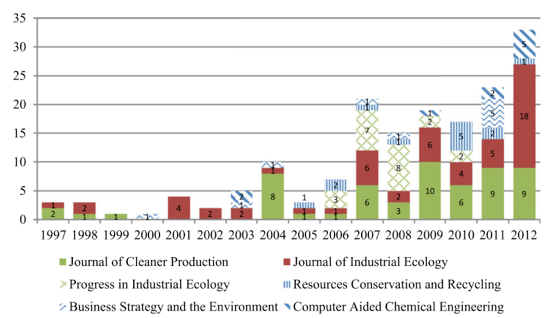
Source: Yu et al. (2013).
Although historical evolution has taken place, the time of development of the industries has differed. Not all industries pass through the same phases. Frondel et al. (2007) reported that 3,100 (74%) of 4,186 industries considered in some countries of the Organization for Economic Cooperation and Development (OECD) participated in significant measures to reduce environmental impacts via production technology. Meanwhile, 1,086 industries did not report expenditures on new end-of-pipe or cleaner production techniques. Among the 3,100 modifications to installations, 76.8% involved modified production techniques, while 23.2% involved implementation of end-of-pipe technologies.
The Ellen MacArthur Foundation defines the circular economy as an intentionally restorative or regenerative industrial system. In such a system, the end-of-life term of products is replaced with restoration, and focus is placed on switching to the use of renewable energy, eliminating toxic products, and eliminating waste through product design (Ellen MacArthur Foundation, 2015).
The European Union holds a Circular Economy Action Plan that considers the transition to a more circular economy as a way of maintaining the value of products, materials, and resources for as long as possible while minimizing waste. As a result, this would promote a more sustainable economy, reduction in carbon emissions, and efficient use of resources (European Commission, 2015a).
Flows of material in the circular economy are similar to biological cycles because products are designed and planned to have a cyclical metabolism. An information network necessarily exists among different actors, enabling products or byproducts to circulate throughout the economy and to continue to generate value (Braungart et al., 2007). This economic model appears to be one solution for achieving sustainable development since it interconnects environmental aspects with economic challenges. One way to reach the target of reducing carbon emissions is through lessening demand for materials by increasing the life of raw materials and then substituting and reusing them, thereby leading to radical process innovations (Allwood et al., 2010; Ellen MacArthur Foundation, 2015).
In this way, the circular economy is based on the following principles: 1) the projection of products to generate zero waste, i.e., the optimization of products in their design to allow for their disassembly and reuse; 2) the projection of products at the moment of their design for reuse; and 3) the use of renewable energy (Ellen MacArthur Foundation, 2015).
Through the implementation of a circular economy, governments can endorse a viable policy for achieving new means of sustainable development and for promoting eco-efficiency. Thus, in addition to potentially positive environmental impacts resulting from lower dependence on natural resources, society may also be positively impacted through the reduction of poverty rates for those benefitted by this economic model (Geng and Doberstein, 2008). In this sense, circular economies can promote a new business model that allows for both innovation and environmental awareness, or the implementation of economic development without environmental degradation (Geng et al., 2016).
In this approach, sustainable solutions involve moving away from linear, end-of-pipe models or those that solely apply local changes toward a circular economic model of recovery that focuses on the reuse of resources and materials. In this context, the life cycle of products, from their conception, is closed and symbiotic. This article evaluates the current state and development of research on the circular economy in the scientific literature, using bibliometric tools to analyze and relate the main themes, countries, institutions, authors, and journals that have addressed the topic.
This bibliometric study is based on a systematic bibliographical analysis of the literature related to the central study theme, following a rigorous sequence of steps (Biolchini et al., 2005; Brereton et al., 2007), which are described in Figure 2.
First, we defined the search term to be "circular economy.” Other possibilities were "eco-effectiveness," "ecodesign," or other potential terms involving new business models. However, this term was intentionally chosen to verify its consistency of expression in the scientific literature. With this focus, the survival and growth of this topic as well as its indicators were analyzed given the simultaneous development of new ideas and theories (Morse, 2014).
In the second stage, we choose the search engine as the Web of Science database, managed by Thomson Reuters. This database currently indexes the most relevant journals (Figure 2).
Figure 2.
The five stages of the bibliographic analysis of articles addressing circular economy.
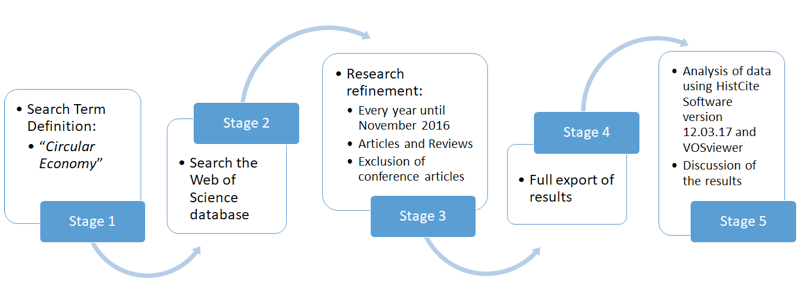
In stage three, we refined the results with the following inclusion and exclusion criteria: Articles and reviews were included. Conferences papers were excluded. Search periods included the indicated year up through November 2016.
In stage four, we exported the results with all available information in ".txt" format, which we used in stage five for the bibliometric analysis with the software HistCite version 12.03.17 and VOSviewer. We used the Data Envelopment Analysis (DEA) method in the SIAD Software to perform efficiency analyses (Meza et al., 2005), taking as an input the number of publications and as outputs the indicators generated by HistCite. The results returned 312 articles, all of which were used in the general analysis to evaluate academic evolution, country of origin, institution, and authorship as well as to perform periodical analyses.
We classified the authors according to the Walter and Bach (2013) production categories (Table 1): starters, transients, continuants, one-timers, and retreating researchers.
Table 1
Bibliometric indicators adopted for authors of studies on circular economy.
Category |
Definition |
Classification criteria |
Starters |
New researchers in the field who have published at least 2 articles in the last 2 years |
≥ 2 articles from 2015 to 2016 No publications until 2014 |
Transients |
Relatively permanent researchers in the field who have published at least 2 articles within 4 years, including one in the last 2 years |
≥ 2 articles with 4 years ≥ 1 article from 2015 to 2016 ≥ 1 article until 2014 |
Continuants |
Consolidated researchers in the area who have published at least 2 articles within 5 years, including in the last 2 years |
≥ 2 articles in ≤ 5 years ≥ 1 article from 2015 to 2016 |
One-timers |
Sporadic researchers who have published only 1 article in the review period |
1 article up to 2016 |
Retreating |
Researchers who are leaving the area and who have published at least 2 articles, though none in the last 3 years |
≥ 2 articles up to 2013 No publications from 2014 to 2016 |
Source: Adapted from Walter and Bach (2013). |
||
Regarding the citation indicators, we adopted and analyzed the indicators provided by the HistCite software, highlighted in Table 2.
Table 2
Bibliometric indicators adopted for studies on circular economy.
Indicator |
Initials |
Description |
Global citation score |
GCS |
The total number of citations that an article in the Web of Science has received |
Local cited references |
LCR |
The number of citations in an article's reference list for other articles within the collection |
Local citation score |
LCS |
The quote count for an item within the collection |
Local citation score per year |
LCS/t |
Local citations per year since publication of article to end of the covered time period |
Global citation score per year |
GCS/t |
Global citation score per year since publication of article to end of the covered time period |
Source: Adapted from the software glossary of HistCite. |
||
The historical development of published articles containing the term "circular economy" in the title, abstract, or keywords in the Web of Science since 2006 is shown in Figure 3.
Figure 3
Evolution of scientific production on "circular economy".
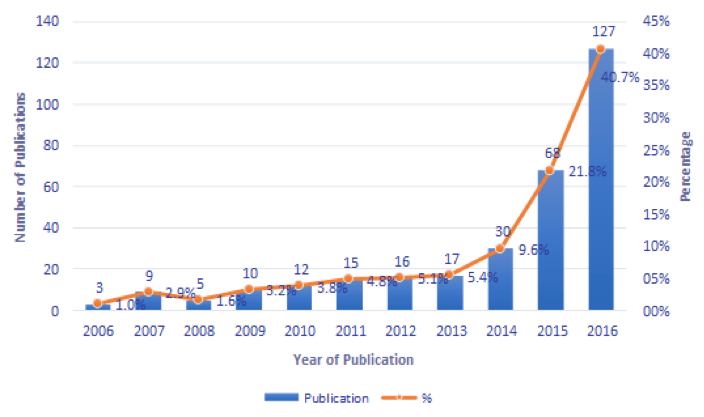
From 2006 to 2013, the number of articles published did not exceed 20. In 2014, the number rose to 30 and in 2015 to 68. In 2016, the number of published articles reached 127, or 40.7% of the total. This growth demonstrates the importance of the theme, coinciding with its adoption as national policy by the Chinese government, which aimed to promote the concepts surrounding circular economy through a series of laws and regulations (Stahel, 2006). More recently in 2015, a proposal was made to amend the European Waste Management Policy in order to include and to promote certain aspects of a circular economy (European Commission, 2015b).
Pearce and Turner (1990) previously approached the concept of circular economy, pointing out in their publication, "Economics of natural resources and the environment," that traditional economies developed without the tendency to recycle or circulate outputs, wherein the environment is treated like a reservoir of residues. The results of this study show the evolution of this theme and how it is still maturing.
As for language, 98.4% of the articles were written in English, followed by 0.6% in German and 0.3% in Chinese, French, and Romanian. The country with the most publications is China (Table 3), accounting for 40.7%. China also ranks first in the LCS and GCS indicators. Faced with pressures from stakeholders, mainly non-governmental organizations, China has sought a balance between the scientific evidence in favor of a circular economy and related political issues in order for national development to be successful (Geng et al., 2013). It is noteworthy that China has been proactive in implementing circular economy at three levels, micro, meso, and macro, and has become an experimental laboratory for entire world (Geng et al., 2016). This support for action derives from laws and public policies, such as the promulgation of the Circular Economy Promotion Law in 2009 (Stahel, 2006; Su et al., 2013; Yong, 2007).
As for the efficiency of the publications (DEA), China ranks sixth according to number of publications (inputs), because the indicators generated (outputs) could be larger, comparing to the first place. In Table 3, the most efficient countries (DEA) are Japan and Germany, which may be considered pioneers in implementing circular economy laws, they had good performance in its indicators. These countries have guided the law applied in China, which is considered the third implementation of world (Yong, 2007).
Table 3
List of countries according to most publications and respective indicators.
Countries |
Amount |
% |
% Rank |
LCS |
CLS Rank |
GCS |
GCS Rank |
DEA |
DEA Rank |
China |
127 |
40.7 |
1 |
397 |
1 |
1439 |
1 |
0.692236 |
6 |
UK |
38 |
12.2 |
2 |
27 |
8 |
356 |
3 |
0.696351 |
5 |
Netherlands |
30 |
9.6 |
3 |
39 |
7 |
240 |
6 |
0.712389 |
3 |
Italy |
27 |
8.7 |
4 |
52 |
5 |
237 |
7 |
0.589628 |
11 |
USA |
24 |
7.7 |
5 |
119 |
2 |
480 |
2 |
0.810889 |
2 |
Japan |
21 |
6.7 |
6 |
72 |
3 |
272 |
5 |
1.000000 |
1 |
Germany |
19 |
6.1 |
7 |
16 |
11 |
86 |
9 |
1.000000 |
1 |
Sweden |
16 |
5.1 |
8 |
5 |
18 |
37 |
15 |
0.589409 |
12 |
Belgium |
11 |
3.5 |
9 |
9 |
14 |
69 |
11 |
0.609537 |
10 |
Denmark |
11 |
3.5 |
9 |
22 |
10 |
57 |
14 |
0.522691 |
24 |
Finland |
9 |
2.9 |
10 |
7 |
16 |
27 |
17 |
0.581197 |
13 |
Spain |
9 |
2.9 |
10 |
1 |
21 |
14 |
19 |
0.531300 |
21 |
Figure 4 shows the relationship between countries in regard to number of citations, wherein a stronger co-citation is expressed by greater line thickness. The closer that two circles are located to one another, the stronger their relationship in terms of co-citation links. The eight strongest relations between countries in terms of co-citations line thickness are between China and the USA (117 points), Japan (110 points), Sweden (80 points), Italy (75 points), Canada (60 points), South Korea (51 points), Netherlands (48 points), and Germany (28 points). Ninth comes the strength of USA and Japan relationship (28 points) and tenth China and Denmark (26 points).
Figure 4
Relations between countries in terms of numbers of citation.
The line thickness indicates the strength of the relation.
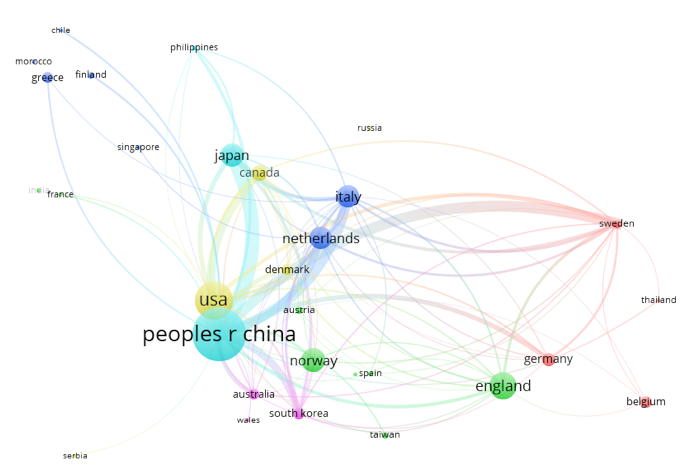
According to Table 4, of the nine institutions with the most publications, six are Chinese. First, the Chinese Academy of Sciences contributed 9.6% of publications. This institution has a research group entitled "Circular Economy and Industrial Ecology Research Group," created in 2008 near the beginning of the search period for publications in the Web of Science. The research of this group focuses on circular economics and industrial ecology along with the development of circular economy simulation systems and eco-efficiency evaluation in industrial ecosystems. The main leader is Dr. Yong Geng, who is the author with the most publications (27) in this sample (Figure 9).
The National Institute for Environmental Studies of Japan also stands out for contributing 5.1% of published articles, as it has a Research Center for Social and Environmental Systems that examines themes of circular economy, ecological towns, and cities with low carbon emissions. In Europe, particularly in the Netherlands, Delft University Technology excels in research on circular economies and focuses on developing products and combinations of services through new business models.
Table 4
List of top publishing institutions and their respective indicators.
Rank |
Institution |
Country |
Amount |
% |
LCS |
GCS |
1 |
Chinese Academy of Sciences |
China |
30 |
9.6 |
200 |
541 |
2 |
National Institute for Environmental Studies |
Japan |
16 |
5.1 |
61 |
238 |
3 |
Delft University Technology |
Netherlands |
14 |
4.5 |
14 |
81 |
4 |
Tsinghua University |
China |
13 |
4.2 |
30 |
113 |
5 |
Dalian University Technology |
China |
12 |
3.8 |
105 |
333 |
6 |
Shanghai Jiao Tong University |
China |
12 |
3.8 |
22 |
188 |
7 |
Shandong University |
China |
8 |
2.6 |
11 |
41 |
8 |
Central South University |
China |
6 |
1.9 |
4 |
10 |
9 |
University of Oxford |
UK |
6 |
1.9 |
4 |
9 |
As shown in Figure 5, the pioneering journals were the Journal of Cleaner Production, Chinese Geographical Science, and the Journal of the Central South University of Technology. The Journal of Cleaner Production was among the first to publish articles on this subject (with the exception of 2008), and this journal contained 37% of publications by 2016. Overall, throughout the evaluated period, the Journal of Cleaner Production represented 25.6% of all publications on average and presented the highest scores for the analyzed indicators, as shown in Table 5. However, in terms of efficiency (DEA), the journal is located in seventh place. In other words, some journals have fewer publications yet better citation indicators, such as the Journal of Industrial Ecology, which contains 4.2% of publications and has a high citation index.
The journals Conservation Resources and Recycling and Sustainability, with 6.7% and 4.5% of publications, respectively, are also noteworthy. Waste Management appears in fifth position with 3.8% of publications. This latter journal published one of the principle articles on the subject from Yong Geng et al. (2009), which has the highest LCS of the sample (36). Overall, the journal has a LCS of 44.
Figure 5
Annual representation of the five journals with the highest share of publications.
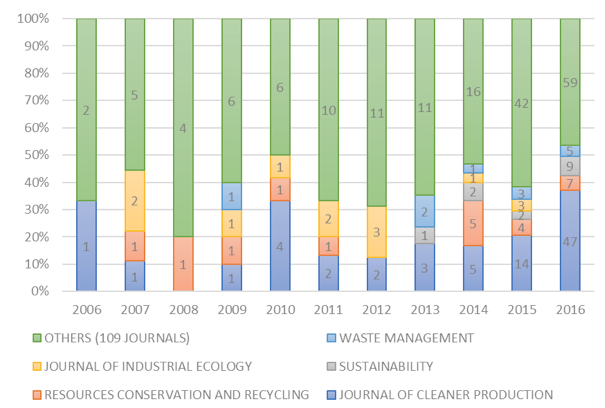
-----
Table 5
List of journals with the highest share of publications and their respective indicators.
Journal |
Amount |
% |
Rank |
LCS |
LCS Rank |
LCS/t |
LCS/t Rank |
GCS |
GCS Rank |
GCS/t |
GCS/t Rank |
LCR |
LCR Rank |
DEA |
DEA Rank |
|
Journal of Cleaner Production |
80 |
25.6 |
1 |
228 |
1 |
66.91 |
1 |
752 |
1 |
199.89 |
1 |
335 |
1 |
0.83396 |
7 |
|
Resources Conservation and Recycling |
21 |
6.7 |
2 |
49 |
3 |
10.72 |
2 |
185 |
4 |
38.35 |
3 |
34 |
3 |
0.68110 |
22 |
|
Sustainability |
14 |
4.5 |
3 |
2 |
17 |
0.58 |
23 |
18 |
18 |
7.50 |
15 |
12 |
4 |
0.55133 |
34 |
|
Journal of Industrial Ecology |
13 |
4.2 |
4 |
50 |
2 |
10.64 |
3 |
257 |
3 |
50.66 |
2 |
42 |
2 |
0.83716 |
6 |
|
Waste Management |
12 |
3.8 |
5 |
44 |
4 |
7.33 |
4 |
75 |
7 |
15.54 |
7 |
6 |
8 |
0.67384 |
24 |
|
Bioresource Technology |
8 |
2.6 |
6 |
3 |
16 |
3.00 |
8 |
8 |
25 |
7.50 |
15 |
3 |
11 |
0.57934 |
32 |
|
Figure 6 shows the relationship between the journals in term of citations. Once again, the central role of the Journal of Cleaner Production is evident. The ten journals with the greatest number of articles cited from the Journal of Cleaner Production include the Journal of Industrial Ecology (44 points), Resources Conservation and Recycling (34 points), Waste Management (24 points), International Journal of Sustainable Development and World Ecology (19 points), Journal of Material Cycles and Waste Management (18 points), Environmental Science and Pollution Research (13 points), Sustainability Science (13 points), Science of the Total Environment (11 points), and Sustainability (10 points).
Figure 6
Relationships between the journals in term of number of citations.
The line thickness indicates the strength of the relationship.
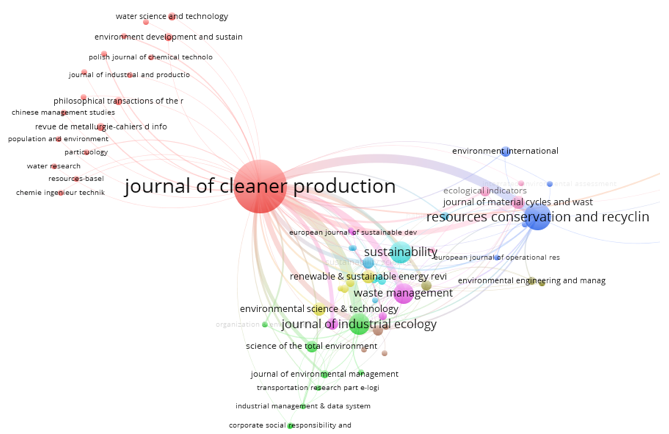
The main keywords besides circular economy in terms of number of occurrences are presented in Figure 7: China (42), industrial symbiosis (26), industrial ecology (20), recycling (20), sustainability (23), sustainable development (17), eco-efficiency (11), resource efficiency (11), and waste management (9). The strongest relationship was found between the terms "circular economy" and "China," emphasizing the scientific relevance of this country in this emerging area of research.
Notably, waste management was well intertwined with circular economy, as the cyclical nature of a circular economy implicates recycling and reuse as well as a shift in sources of raw materials and a transition from fossil fuels to renewable energy, resulting in efficiency gains. Therefore, recycling may be considered a generalized strategy for achieving the objectives of a circular economy (Haas et al., 2015), as also highlighted in the European proposal directive to promote circular economies (European Commission, 2015b).
This result reinforces the conclusion of Lieder and Rashid (2016) that the circular economy has evolved from research on waste generation, resource utilization, and environmental impacts. The inclusion of keywords such as “sustainability” and “sustainable development” also evidenced these results. Even so, these authors claim that studies from commercial and economic perspectives have been neglected (Lieder and Rashid, 2016).
Some authors have affirmed that in an eco-efficient circular system, the system will first seek the dematerialization of products and services. Later, necessary products will be developed for remanufacturing, renovation, and recycling. In this sense, the system should aim to insert recycling in the latest possible cycle because it represents a close-ended solution (Braungart et al., 2007; Ellen MacArthur Foundation, 2015).
Figure 7
Keywords with at least four occurrences.
The line thickness indicates the strength of the relationship.
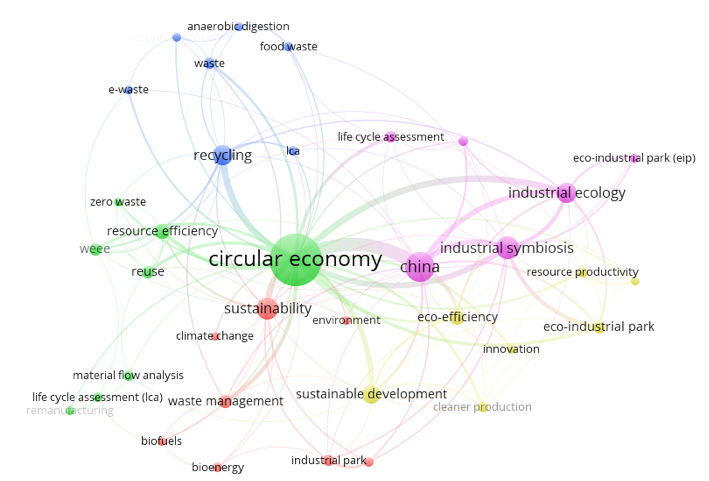
For the author categories (Table 6), we first identified 895 different authors. The most prominent authors were the one-timers, totaling 85.81% of authors. Meanwhile, the starters, transients, continuants, and retreating authors had low representativeness. Among these, starter authors were the most common (5.25%), reinforcing the recent nature of the theme and its potential for further development in the scientific literature and for the entry of new researchers. Or, perhaps this could mean that established researched take on the theme although their main research focus is in another area. The authors, who have published in this area might consider it more of a side road rather than their main research area.
Table 6
Author categories according to number and frequency
of publications in circular economy themes.
Category |
Number of Authors |
% |
Starters |
47 |
5.25 |
Transients |
44 |
4.92 |
Continuants |
14 |
1.56 |
One-timers |
768 |
85.81 |
Retreating |
22 |
2.46 |
Total |
895 |
100.00 |
The continuant authors who are consolidated researchers in the field that have published at least two articles within five different years, including the last two years, represent only 1.56% of authors. Only 14 authors fall into this category. The importance of the consolidated authors in the area is shown in the network of generated connections in Figure 8. Geng, Y., is the main author and has 27 papers, a LCS of 202, and a GCS of 537; his strongest link (52 points) occurs with the author Fujita, T., who has 10 publications, a LCS of 64, and a GCS of 197. Then, with Zhu, Q.H., there is a corresponding link strength of 37; this author also has 10 publications, a LCS of 59, and a GCS of 229. The third largest link occurs between Geng, Y., and Xue, B., with a score of 36; this latter author has 8 publications, a LCS of 60, and a GCS of 186. The fourth largest link (35 points) is with Geng, Y., and Sarkis, J., who published 7 articles and has a LCS of 60 and a GCS of 169.
Figure 8
Authors with at least three publications and their connections.
The line thickness indicates the strength of the relationship.
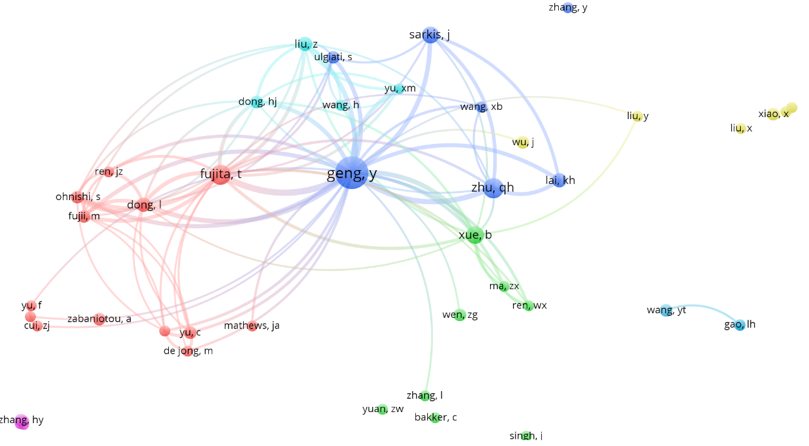
More publications do not necessarily mean more citations, although the highest LCS of the sample does correspond with the author Geng, Y. In second place comes Doberstein, B., with only 2 publications yet an LCS of 67; however, in these two publications, Geng, Y., is the first author. Figure 9 illustrates how these two publications (IDs 20 and 15) have the largest LCS and have been linked with the top 15 publications. Both articles are crucial in the literature of circular economy, as observed in Figure 9.
The article with the highest LCS of 36 (ID 20) by Yong Geng et al. (2009) involved a case study in the city of Dalian in China, where circular economic practices were implemented as a means of conserving natural resources. The article describes several successful initiatives and details the approaches used during their implementation. Based on the Chinese Circular Economy Promotion Law of January 1, 2009, the Dalian municipal government developed the Circular Economy Promotion Ordinance on October 1, 2010. This ordinance has led to a prominent focus on creating a more environmentally friendly city, and several case studies have addressed the city’s experience with waste (Qu et al., 2013), industrial symbiosis (Zhe et al., 2016), and a well-city model in favor of a circular economy (Su et al., 2013).
The article with the second largest LCS of 31 (ID 15) also addresses the circular economy in China, illustrating how environmental damage may be avoided in once committed industrialized economies. The article presents the development of the circular economic model in China, showing the current practices and measures adopted in favor of a circular economy in the long term, including public policies. The authors identify several barriers and challenges still present in this area in addition to outlining the future of circular economies (Geng and Doberstein, 2008).
Figure 9
Relationship map of the 15 best evaluated publications according to the LCS indicator.
The size of the circle represents the magnitude of LCS.
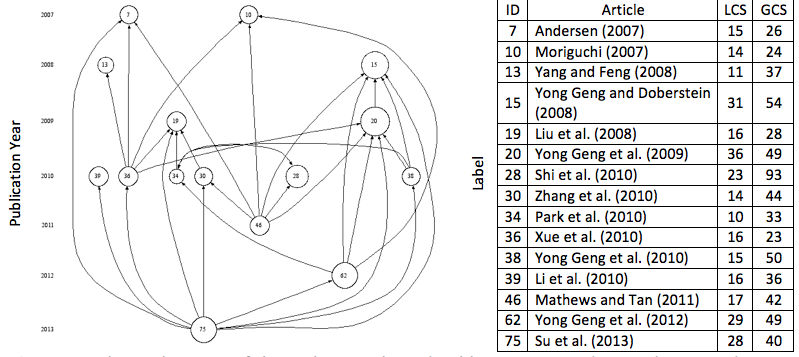
Among the highlighted articles, the review (ID 75) of Su et al. (2013) stands out, as it cites several of the key articles highlighted in Figure 9. This review focuses on China and covers the concepts of circular economy, current practices, and an assessment of a circular economy through the use of indicators. The authors conclude that there are some problems and challenges that China must solve, resulting from the lack of accurate information, technology, public awareness, and system assessments as well as poor economic incentives and leadership.
The concepts that formulate circular economy still have room to mature in terms of theoretical and practical research in order to consequently inform and generate greater global, political, economic, social, and environmental impacts. Studies in the following areas are necessary:
The economic model of the world is predominantly a linear system of extracting, transforming, and discarding, for which low cost extraction of raw materials is necessary. The circular economy modifies this systems by reducing pressure on natural resources and by moving toward circular processes, or the cycling of inputs and outputs, within the system. In this study, the theme of circular economy was subjected to a bibliometric analysis. Circular economy was found to be an emerging theme. From 2006 to 2013, the number of related academic publications did not exceed 20, in 2014 reached 30, in 2015 rose to 68, and in 2016 peaked at 127 articles, or 40.7% of the total.
The results show that the main country in terms of number of publications is China, accounting for 40.7% of all publications. China is also a leader in the establishment of indicators for circular economy. This country, like other developed countries, has implemented public policies aimed at developing a circular economy. Among the ten institutions that have a higher number of publications, six are Chinese, and the Chinese Academy of Sciences is a prominent source of publications.
With respect to citations, there are strong relationships between China, a newly industrialized country, and advanced economies. This relation shows the embeddedness of China in the world market and their advances in technological-scientific development. In addition, this demonstrates a basis for future relationships and possible trends. The commercial relationship between different countries could also be explored as part of the shift toward a new circular economic model, as this appears to be an increasing tendency toward the future.
The results clearly show the leadership of the Journal of Cleaner Production. In 2016, this journal accounted for 37% of the publications on circular economy, and, throughout the studied period, it represented 25.6% of all publications, on average, and also presented the best citation indicators.
As for the main keywords, we found “China,” “industrial symbiosis,” “industrial ecology,” “recycling,” “sustainability,” “sustainable development,” “eco-efficiency,” “resource efficiency”, and “waste management.” We emphasized that waste management is still closely linked to the concepts of circular economy, wherein recycling is one strategy used to achieve the objectives of a circular economy.
Of the authors identified, most are one-timers (85.81%) or have only published once. The starters, transients, continuants, and retreating authors had low representativity. The number of starter authors (5.25%) reinforced that the circular economy is still a newly developing issue and that there is room for this theme to future mature in the scientific literature. Among the continuant authors, Dr. Geng, Y., is prominent, with 27 publications.
The field of research on circular economy still has a long way to go in order to generate positive global, political, economic, scientific, social, and environmental impacts. There is a need for studies in various subareas in order to highlight the potential impacts of circular economies in the present and the future as well as for research to find ways to accelerate an economic transition toward a circular economy.
This study presents some limitations. The only keyword selected was “circular economy” (when located in the title, abstract, or keywords), meaning that valuable papers such as those of Fujii et al. (2016) and Qu et al. (2013) that address policy implications for the development of circular economies and have strong linkages with this theme were not analyzed in the sample. Even so, we have assumed that papers with a principal focus on circular economy have used this term in the title, abstract, or keywords and that these are included in the research database.
Allwood, J. M., Cullen, J. M., and Milford, R. L. (2010). Options for achieving a 50% cut in industrial carbon emissions by 2050. Environmental Science and Technology, 44(6), 1888–1894.
Andersen, M. S. (2007). An introductory note on the environmental economics of the circular economy. Sustainability Science, 2(1), 133–140.
Biolchini, J., Mian, P. G., Natali, A. C. C., and Travassos, G. H. (2005). Systematic review in software engineering. Systems Engineering and Computer Science Department. Rio de Janeiro. Retrieved from http://www.cin.ufpe.br/~in1037/leitura/systematicReviewSE-COPPE.pdf
Brasil. Decreto no 73.030, de 30 de outubro de 1973. Cria, no âmbito do Ministério do Interior, a Secretaria Especial do Meio Ambiente - SEMA, e dá outras providências. (1973). Brasil. Retrieved from http://www2.camara.leg.br/legin/fed/decret/1970-1979/decreto-73030-30-outubro-1973-421650-publicacaooriginal-1-pe.html
Braungart, M., McDonough, W., and Bollinger, A. (2007). Cradle-to-cradle design: creating healthy emissions - a strategy for eco-effective product and system design. Journal of Cleaner Production, 15(13–14), 1337–1348.
Brereton, P., Kitchenham, B. A., Budgen, D., Turner, M., and Khalil, M. (2007). Lessons from applying the systematic literature review process within the software engineering domain. Journal of Systems and Software, 80(4), 571–583.
Chertow, M. R. (2000). Industrial symbiosis: literature and taxonomy. Annual Review of Energy and the Environment, 25(1), 313–337.
Deus, R. M., Battistelle, R. A. G., and Silva, G. H. R. (2015). Solid waste in Brazil: context, gaps and trends. Engenharia Sanitária e Ambiental, 20(4), 685-698.
Deus, R. M., Battistelle, R. A. G., and Silva, G. H. R. (2017a). Current and future environmental impact of household solid waste management scenarios for a region of Brazil: carbon dioxide and energy analysis. Journal of Cleaner Production, 155(1), 218–228.
Deus, R. M., Battistelle, R. A. G., and Silva, G. H. R. (2017b). Scenario evaluation for the management of household solid waste in small Brazilian municipalities. Clean Technologies and Environmental Policy, 19(1), 205–214.
Ellen MacArthur Foundation. (2015). Towards a Circular Economy: Business rationale for an accelerated transition. Ellen MacArthur Foundation. Ellen MacArthur Foundation.
European Commission. (2015a). Closing the loop - An EU action plan for the Circular Economy. Retrieved from http://eur-lex.europa.eu/legal-content/EN/TXT/?uri=CELEX:52015DC0614
European Commission. (2015b). Proposal for a Directive of the European Parliament and of the Council amending Directive 2008/98/EC on waste. Retrieved from http://eur-lex.europa.eu/legal-content/EN/TXT/?uri=CELEX:52015PC0595
Frondel, M., Horbach, J., and Rennings, K. (2007). End-of-pipe or cleaner production? An empirical comparison of environmental innovation decisions across OECD countries. Business Strategy and the Environment, 16(8), 571–584.
Fujii, M., Fujita, T., Dong, L., Lu, C., Geng, Y., Behera, S. K., Park, H. S. and Chiu, A. S. F. (2016). Possibility of developing low-carbon industries through urban symbiosis in Asian cities. Journal of Cleaner Production, 114, 376-386.
Geng, Y., and Doberstein, B. (2008). Developing the circular economy in China: Challenges and opportunities for achieving’leapfrog development’. International Journal of Sustainable Development and World Ecology, 15(April 2016), 231–239.
Geng, Y., Fu, J., Sarkis, J., and Xue, B. (2012). Towards a national circular economy indicator system in China: An evaluation and critical analysis. Journal of Cleaner Production, 23(1), 216–224.
Geng, Y., Sarkis, J., and Ulgiati, S. (2016). Sustainability, well-being, and the circular economy in China and worldwide. Science, 6278(Suppl.), 73-76.
Geng, Y., Sarkis, J., Ulgiati, S., and Zhang, P. (2013). Measuring China's circular economy. Science, 339(6127), 1526-1527.
Geng, Y., Zhang, P., Ulgiati, S., and Sarkis, J. (2010). Emergy analysis of an industrial park: The case of Dalian, China. Science of the Total Environment, 408(22), 5273–5283.
Geng, Y., Zhu, Q., Doberstein, B., and Fujita, T. (2009). Implementing China’s circular economy concept at the regional level: A review of progress in Dalian, China. Waste Management, 29(2), 996–1002.
Gentil, E., Clavreul, J., and Christensen, T. H. (2009). Global warming factor of municipal solid waste management in Europe. Waste Management and Research, 27(9), 850–860.
Georgescu, M., Morefield, P. E., Bierwagen, B. G., and Weaver, C. P. (2014). Urban adaptation can roll back warming of emerging megapolitan regions. Proceedings of the National Academy of Sciences, 111(8), 2909–2914.
Haas, W., Krausmann, F., Wiedenhofer, D., and Heinz, M. (2015). How circular is the global economy?: An assessment of material flows, waste production, and recycling in the European union and the world in 2005. Journal of Industrial Ecology, 19(5), 765–777.
Hoffman, A. J. (1999). Institutional Evolution and Change: Environmentalism and the U.S. Chemical Industry. The Academy of Management Journal, 42(4), 351–371.
Hoornweg, D., Bhada-Tata, P., and Kennedy, C. (2013). Environment: Waste production must peak this century. Nature, 502(7473), 615.
Hou, Q., Mao, G., Zhao, L., Du, H., and Zuo, J. (2015). Mapping the scientific research on life cycle assessment: a bibliometric analysis. The International Journal of Life Cycle Assessment, 20(4), 541–555.
ISO. (2006). ISO 14044:2006. ISO.
Krausmann, F., Erb, K.-H., Gingrich, S., Haberl, H., Bondeau, A., Gaube, V., Searchinger, T. D. (2013). Global human appropriation of net primary production doubled in the 20th century. Proceedings of the National Academy of Sciences, 110(25), 10324–10329.
Li, H., Bao, W., Xiu, C., Zhang, Y., and Xu, H. (2010). Energy conservation and circular economy in China’s process industries. Energy, 35(11), 4273–4281.
Lieder, M., and Rashid, A. (2016). Towards circular economy implementation: A comprehensive review in context of manufacturing industry. Journal of Cleaner Production, 115, 36–51.
Liu, Q., Li, H.-M., Zuo, X.-L., Zhang, F.-F., and Wang, L. (2008). A survey and analysis on public awareness and performance for promoting circular economy in China: A case study from Tianjin. Journal of Cleaner Production, 17(2), 265–270.
Mathews, J. A., and Tan, H. (2011). Progress toward a circular economy in China: The drivers (and inhibitors) of eco-industrial initiative. Journal of Industrial Ecology, 15(3), 435–457.
Meza, L. A., Neto, L. B., Mello, J. C. C. B. S., and Gomes, E. G. (2005). ISYDS- Integrated System for Decision Support (SIAD - Sistema Integrado de Apoio a Decisão): a software package for data envelopment analysis model. Pesquisa Operacional, 25(3), 493–503.
Moriguchi, Y. (2007). Material flow indicators to measure progress toward a sound material-cycle society. Journal of Material Cycles and Waste Management.
Morse, S. (2014). Stirring the pot. Influence of changes in methodology of the Human Development Index on reporting by the press. Ecological Indicators, 45, 245–254.
Park, J., Sarkis, J., and Wu, Z. (2010). Creating integrated business and environmental value within the context of China’s circular economy and ecological modernization. Journal of Cleaner Production, 18(15), 1492–1499.
Pearce, D. W., and Turner, R. K. (1990). Economics of natural resources and the environment (Vol. 73). Baltimore: The John Hopkis Univerity Press.
Seager, T. P., and Theis, T. L. (2002). A uniform definition and quantitative basis for industrial ecology. Journal of Cleaner Production, 10(3), 225–235.
Shi, H., Chertow, M., and Song, Y. (2010). Developing country experience with eco-industrial parks: a case study of the Tianjin Economic-Technological Development Area in China. Journal of Cleaner Production, 18(3), 191–199.
Souza, C. G. de, and Barbastefano, R. G. (2011). Knowledge diffusion and collaboration networks on life cycle assessment. International Journal of Life Cycle Assessment, 16(6), 561–568.
Stahel, W. R. (2006). The circular economy: a new development strategy in China. Journal of Industrial Ecology, 10(1–2), 4–8.
Su, B., Heshmati, A., Geng, Y., and Yu, X. (2013). A review of the circular economy in China: Moving from rhetoric to implementation. Journal of Cleaner Production, 42, 215–227.
Velloso, M. P. (2008). Os restos na história: percepções sobre resíduos. Ciência e Saúde Coletiva, 13(6), 1953–1964.
Vergara, S. E., and Tchobanoglous, G. (2012). Municipal Solid Waste and the Environment: A Global Perspective. Annual Review of Environment and Resources, 37(1), 277–309.
Walter, S. A., and Bach, T. M. (2013). Inserção de Pesquisadores Entrantes na Área de Estratégia: Análise das Relações de Autoria e Temas Estudados no Período de 1997-2010. REAd, 19(1), 165–191.
Xue, B., Chen, X. P., Geng, Y., Guo, X. J., Lu, C. P., Zhang, Z. L., and Lu, C. Y. (2010). Survey of officials’ awareness on circular economy development in China: Based on municipal and county level. Resources, Conservation and Recycling, 54(12), 1296–1302.
Yang, S., and Feng, N. (2008). A case study of industrial symbiosis: Nanning Sugar Co., Ltd. in China. Resources, Conservation and Recycling, 52(5), 813–820.
Yong, R. (2007). The circular economy in China. Journal of Material Cycles and Waste Management, 9(2), 121–129.
Yu, C., Davis, C., and Dijkema, G. P. J. (2013). Understanding the Evolution of Industrial Symbiosis Research: A Bibliometric and Network Analysis. Journal of Industrial Ecology, 18(2), 280–293.
Zhang, L., Yuan, Z., Bi, J., Zhang, B., and Liu, B. (2010). Eco-industrial parks: national pilot practices in China. Journal of Cleaner Production, 18(5), 504–509.
Zhe, L., Yong, G., Hung-Suck, P., Huijuan, D., Liang, D., and Tsuyoshi, F. (2016). An emergy-based hybrid method for assessing industrial symbiosis of an industrial park. Journal of Cleaner Production, 114, 132-140.
1. Department of Production Engineering, São Paulo State University (UNESP), School of Engineering, Av. Eng. Luiz Edmundo Carrijo Coube, 14-01, CEP 17033-360, Bauru, SP, Brazil. rafaelmdeus@gmail.com
2. Department of Civil Engineering, University of São Paulo (USP), São Carlos School of Engineering, Avenida dos Trabalhadores São-Carlense, 400, Parque Arnold Schimidt, CEP 13566-590, São Carlos, SP, Brazil. ju.savietto@gmail.com
3. Department of Production Engineering, São Paulo State University (UNESP), School of Engineering, Av. Eng. Luiz Edmundo Carrijo Coube, 14-01, CEP 17033-360, Bauru, SP, Brazil. rosane@feb.unesp.br
4. Department of Production Engineering, University of São Paulo (USP), São Carlos School of Engineering, Avenida dos Trabalhadores São-Carlense, 400, Parque Arnold Schimidt, CEP 13566-590, São Carlos, SP, Brazil. aometto@sc.usp.br